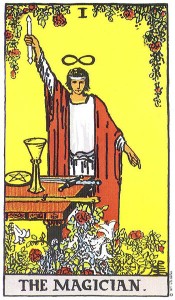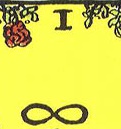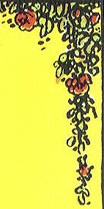Podcast: Play in new window | Download
[Here is the second Tarot meditation, on The Magician. With card Zero we met the Fool, walking off the cliff to start his journey (our journey) deep within, and now we meet this Magician, who points and offers what we need.]
The first person we come across after our fall from the Fool’s ledge is the Magician, standing there calm and still to greet us. This is a sumptuous picture, full of warm yellows and reds, framed by flowers.
As the Fool’s card moved from the upper right to lower left, so this card moves from upper left to lower right. This opposite movement arrests our fall. We are on the earth again.
The right hand looks like it is raised in greeting, but we discover that it is holding something, pointed to the heavens. The left hand certainly is pointing to something for us. Taken together both hands seem to be offering one complete gesture, which unifies heaven and earth, above and below.
In truth certainly and without doubt
whatever is below is like that which is above,
and whatever is above is like that which is below,
to accomplish the miracles of one thing.
The number one, the single upright stroke, represents the masculine energy, and the Magician is often taken to be a symbol of the conscious, yang part of the self, the active one, the doer. And here he stands with an instrument in his hand, and tools before him on the table, like a good workman.
But what is this workman doing? Apparently, nothing.
In fact like the Fool he is androgynous, male and female. Below the straight lines and angles of the Roman numeral appear the feminine curves of the number 8, lying on its side, transformed into the sign of infinity, offering endless possibilities. Not doing, just being, not one but all things.
Here are the two ways a numeral can move forward from the zero of the Fool. It can move to the next number – to one – or it can double the zero, forming two zeroes side by side: infinity.
Other parts of the image also remind us of this combination of male and female symbols: the masculine wand in the Magician’s right hand, paired with the Orobouros – the snake eating itself in an infinite circle – around the Magician’s waist. On the table are the male sword and staff, and the female cup and circle. The two directions of the Magician’s arms: up to the conscious, male heavens, and down, to the unconscious, feminine underworld.
Think again what this man–woman is doing. Signalling? Channelling? Opening himself/herself for something to pass down the arms, from above to below? The work this balanced figure performs is simply the unification of the two poles, standing there in active stillness.
At the still point of the turning world. Neither flesh nor fleshless;
Neither from nor towards; at the still point, there the dance is,
But neither arrest nor movement.
This is the first message we encounter after our fall: the silent, expectant motionlessness of unity. A moment of balance and stability to help us prepare for our journey.
* * *
The Magician’s openness feels like an invitation, perhaps an invitation to make use of the objects lying between him and us. For in one sense here in the first card of our journey, we find ourselves at the provisioner’s table, collecting the tools needed for our journey, tools provided for us. These tools are not entirely ours, as we are reminded by the pentacle, sword, and staff being each cut off by the frame: we do not have access to the whole tool. We are only borrowing the tools for use at the moment. Nor are the tools entirely the Magician’s; he stands only partially behind the table, not possessing them completely, ready to give them up.
What are these tools? What is on offer here? Four signifies completeness: the four elements earth, water, air, fire; the four directions, and here the four suits making up the whole Tarot deck – Cup, Pentacle or Coin, Sword, and Staff. Everything we need is right here.
There is the Cup for nourishment. This is an elegant goblet, with a long stem that we can get a firm grasp of. It is not for dainty drinking. We are invited to drink deeply on this journey. This is also a chalice, confirming that what we drink will give us life of the deepest kind, nourishing our soul as well as our body.
But whosoever drinketh of the water that I shall give him shall never thirst; but the water that I shall give him shall be in him a well of water springing up into everlasting life.
Touching the Cup is the Pentacle. Here is a Coin for us to use in exchange for what we may need further on the journey, a token that may open doors for us – but only if we give it away. Coins are round to remind us of the cycle of exchange: it is only by giving that we receive.
This disc with the five-pointed star can also be a shield, a protection against whatever may threaten us, like the shield Sir Gawain carried on his quest to the Green Chapel,
a shield of shining gules,
With the Pentangle in pure gold depicted thereon.
…
It is a symbol which Solomon conceived once
To betoken holy truth, by its intrinsic right,
For it is a figure which has five points,
And each line overlaps and is locked with another;
And it is endless everywhere, and the English call it,
In all the land, I hear, the Endless Knot.
The Sword lies on the table, its hilt ready for our right hand. Indeed it is partly extended beyond the table, inviting us eagerly to make use of it. The Sword cuts, a sign of discernment; it can stab, a sign of will power. The Sword is the gift of mental sharpness we need as we travel.
Finally there lies closest to us the Staff. Pilgrims and other travellers use such tools to enable them to continue journeying even when they are exhausted or wounded. The Staff is the sign of endurance. Behind endurance lies hopefulness, seen here with the new growth of leaves sprouting from the wooden pole. This Staff is alive.
* * *
Before these objects laid out on the table are offered to us, there is another offering. This is no ordinary table but an altar, a place for holy offerings. We link above and below by offering up the things below, the objects of our material world, so that they can be blessed by the energy from above. Before we take up our tools, then, we make a sacrifice, offering up and sanctifying what we are about to use. But it is not a priest standing before the altar, sacrificing life, but only the Magician, transforming the things of this world, by letting the holy energy pass through them so that tools below, they can serve the purpose of above.
The card unifies above and below also through the flowers, which cascade down from above and grow up from below. Some lilies look upward; some look downward. The flowers symbolise the manifestation of the energy on earth – the flowering of our hopes and intentions. The rose represents that beauty we all are seeking. The lily is a witness to Annunciation. The flowers, asymmetrically arranged, suggest motion. The roses awaken our impulses of desire; the lilies alert our senses to something being told us. There is a lot of unseen action going on inside us as we look at this picture.
Much is communicated here through the active silence in this picture. It may take us some time to understand what is being communicated, but there is no rush. After all, the Magician stands under the sign of timeless infinity.
Like the Fool the Magician wears white next to his skin: that divine energy that radiated out from the white sun behind the Fool clings also to the Magician, and is repeated in his holy wand, and in the flowering lilies. Also in the thin white headband – silver? – that encircles his brow, showing that his mind is focused on the divine.
* * *
The divine connection can be identified with Mercury, the god traditionally associated with this card. Considering Mercury’s attributes leads us deeper into the wisdom of this card.
Mercury is the trickster god, never saying anything outright but always working through indirection. He is also the god of communication. And so we have met him in this card that speaks indirectly through images, not clear words. We are being encouraged to develop our own skills at reading what lies behind the surface, where the significant meanings are found.
Tell all the Truth but tell it slant —
Success in Circuit lies —
Too bright for our infirm Delight
The Truth’s superb surprise
As Lightning to the Children eased
With explanation kind
The Truth must dazzle gradually
Or every man be blind —
This trickster god is also a thief. Magicians can transform things, but they can also make things disappear. Here is a warning to be on our guard as we go on.
Mercury was also known as the psychopomp, the one who led souls to the Underworld, the world of shadows. The Fool steps into his shadow and instantly meets a guide to the world he has chosen. The Magician’s left hand points the way for us – down into our unconscious, to those things below our world of consciousness.
The white wand, the white lilies’ annunciation, the white arms pointing: all these confirm Mercury’s final role as the messenger from heaven to us below.





